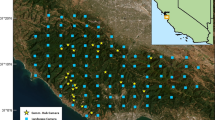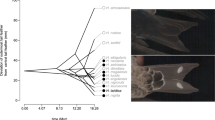Abstract
Like other corvids, food-storing ravens protect their caches from being pilfered by conspecifics by means of aggression and by re-caching. In the wild and in captivity, potential pilferers rarely approach caches until the storers have left the cache vicinity. When storers are experimentally prevented from leaving, pilferers first search at places other than the cache sites. These behaviours raise the possibility that ravens are capable of withholding intentions and providing false information to avoid provoking the storers' aggression for cache protection. Alternatively, birds may refrain from pilfering to avoid conflicts with dominants. Here we examined whether ravens adjust their pilfer tactics according to social context and type of competitors. We allowed birds that had witnessed a conspecific making caches to pilfer those caches either in private, together with the storer, or together with a conspecific bystander that had not created the caches (non-storer) but had seen them being made. Compared to in-private trials, ravens delayed approaching the caches only in the presence of storers. Furthermore, they quickly engaged in searching away from the caches when together with dominant storers but directly approached the caches when together with dominant non-storers. These findings demonstrate that ravens selectively alter their pilfer behaviour with those individuals that are likely to defend the caches (storers) and support the interpretation that they are deceptively manipulating the others' behaviour.




Similar content being viewed by others
References
Anderson JR, Vick S-J, Kuroshima H, Kuwahatan H, Fujita K (2001) Training squirrel monkeys (Saimiri scriureus) to deceive: acquisition and analysis of behaviour toward cooperative and competitive trainers. J Comp Psychol 115:282–293
Axelrod R, Hamilton WD (1981) The evolution of cooperation. Science 211:1390–1396
Barta A, Giraldeau L-A (1998) The effect of dominance hierarchy on the use of alternative foraging tactics: a phenotype-limited producer–scrounger game. Behav Ecol Sociobiol 42:217–223
Bertram BCR (1978) Living in groups: predators and prey. In: Krebs JR, Davies NB (eds) Behavioral ecology: an evolutionary approach, 1st edn. Blackwell, Oxford, pp 64–96
Bugnyar T, Heinrich B (2003) Hiding in food caching ravens, Corvus corax. Rev Etol Suppl 5:57
Bugnyar T, Heinrich B (2005) Ravens, Corvus corax, differentiate between knowledgeable and ignorant competitors. Proc R Soc Lond B 272:1641–1646
Bugnyar T, Kotrschal K (2002a) Observational learning and the raiding of food caches in ravens, Corvus corax: is it “tactical” deception? Anim Behav 64:185–195
Bugnyar T, Kotrschal K (2002b) Scrounging tactics in free-ranging ravens. Ethology 108:993–1009
Bugnyar T, Kotrschal K (2004) Leading a conspecific away from food in ravens, Corvus corax? Anim Cogn 7:69–76
Bugnyar T, Stöwe M, Heinrich B (2004) Ravens, Corvus corax, follow gaze direction of humans around obstacles. Proc R Soc Lond B 271:1331–1336
Byrne RW, Whiten A (1985) Tactical deception of familiar individuals in baboons (Papio ursinus). Anim Behav 33:669–672
Byrne RW, Whiten A (1990) Tactical deception in primates: the 1990 database. Primate Rep 27:1–101
Byrne RW, Whiten A (1992) Cognitive evolution in primates: evidence from tactical deception. Man 27:609–627
Cheney DL, Seyfarth R (1990a) How monkeys see the world: inside the mind of another species. University of Chicago Press, Chicago
Cheney DL, Seyfarth R (1990b) Attending to behavior versus attending to knowledge: examining monkeys’ attribution of mental states. Anim Behav 40:742–753
Coussi-Korbel S (1994) Learning to outwit a competitor in mangabeys (Cercocebus torquatus torquatus). J Comp Psychol 108:164–171
Dally JM, Emery NJ, Clayton NS (2005a) Cache protection strategies by Western scrub-jays (Aphelocoma californica): implications for social cognition. Anim Behav 70:1251–1263
Dally JM, Emery NJ, Clayton NS (2005b) The social suppression of caching in Western scrub-jays (Aphelocoma californica). Behaviour 142:961–977
Dawkins R, Krebs JR (1978) Animal signals: information or manipulation? In: Krebs JR, Davies NB (eds) Behavioral ecology: an evolutionary approach, 1st edn. Blackwell, Oxford, pp 282–309
Dennett DC (1988) The intentional stance in theory and practise. In: Byrne RW, Whiten A (eds) Machiavellian intelligence: social expertise and the evolution of intellect in monkeys, apes and humans. Oxford University Press, Oxford, pp 180–202
Ducoing AM, Thierry B (2003) Withholding information in semifree-ranging tonkean macaques (Macaca tonkeana). J Comp Psychol 117:67–75
Emery NJ, Clayton NS (2001) Effects of experience and social context on prospective caching strategies by scrub jays. Nature 414:443–446
Emery NJ, Clayton NS (2004a) The mentality of crows: convergent evolution of intelligence in corvids and apes. Science 306:1903–1907
Emery NJ, Clayton NS (2004b) Comparing the complex cognition of birds and primates. In: Rogers LJ, Kaplan G (eds) Comparative vertebrate cognition: are primates superior to non-primates? Kluwer Academic, Hague, The Netherlands, pp 3–55
Emery NJ, Dally JM, Clayton NS (2004) Western scrub-jays (Aphelocoma californica) use cognitive strategies to protect their caches from thieving conspecifics. Anim Cogn 7:37–43
Fujita K, Kuroshima H, Masuda T (2002) Do tufted capuchin monkeys (Cebus apella) spontaneously deceive opponents? A preliminary analysis of an experimental food-competition contest between monkeys. Anim Cogn 5:19–25
Giraldeau L-A, Caraco T (2000) Social foraging theory. Princeton University Press, Princeton New Jersey
Güzeldere G, Nahmias E, Deaner R (2002) Darwin's continuum and the building blocks of deception. In: Bekoff M, Allen C, Burghardt GM (eds) The cognitive animal. Empirical and theoretical perspectives on animal cognition. MIT Press, Cambridge, MA, pp 353—362
Hare B, Call J, Agnetta B, Tomasello M (2000) Chimpanzees know what conspecifics do and do not see. Anim Behav 59:771–785
Hare B, Call J, Tomasello M (2001) Do chimpanzees know what conspecifics know? Anim Behav 61:139–151
Hauser MD (1997) Minding the behaviour of deception. In: Whiten A, Byrne RW (eds) Machiavellian intelligence II: Extensions and evaluations. Cambridge University Press, Cambridge, UK, pp 112–143
Heinrich B (1999) Mind of the raven. Harper-Collins, New York
Heinrich B, Pepper J (1998) Influence of competitors on caching behavior in common ravens, Corvus corax. Anim Behav 56:1083–1090
Held S, Mendl M, Devereux C, Byrne RW (2000) Social tactics of pigs in a competitive foraging task: the “informed forager paradigm”. Anim Behav 59:569–576
Held S, Mendl M, Devereux C, Byrne RW (2002) Foraging pigs alter their behavior in response to exploitation. Anim Behav 64:157–166
Heyes CM (1998) Theory of mind in nonhuman primates. Behav Brain Sci 21:101–148
Hirata S, Matsuzawa T (2001) Tactics to obtain a hidden food item in chimpanzee pairs (Pan troglodythes). Anim Cogn 4: 285–295
Kabicher G, Fritz J (1996) Handaufzucht von Kolkraben. ÖKO-L 18:21–28
Kijne M, Kotrschal K (2002) Neophobia affects choice of food-item size in group foraging common ravens (Corvus corax). Acta Ethol 5:13–18
Krebs JR, Dawkins R (1984) Animal signals: mind-reading and manipulation. In: Krebs JR, Davies NB (eds) Behavioral ecology: an evolutionary approach, 2nd edn. Blackwell, Oxford, pp 380–402
Kummer H, Anzenberger G, Hemelrijk CK (1996) Hiding and perspective taking in long-tailed macaques (Macaca fascicularis). J Comp Psychol 110:97–102
Laland KN (2004) Social learning strategies. Learn Behav 32:4–14
Maynard Smith J (1979) Game theory and the evolution of behaviour. Proc R Soc Lond B 205:475–488
Menzel EW Jr (1974) A group of young chimpanzees in a one-acre field: leadership and communication. In: Schrier AM, Stollnitz F (eds) Behavior of nonhuman primates, vol 5. Academic Press, San Diego, CA, pp 83–153
Mitchell RW (1986) A framework for discussing deception. In: Mitchell RW, Thompson NS (eds) Deception: perspectives on human and non-human deceit. State University of New York Press, Albany, NY, pp 3–10
Mitchell RW, Anderson JR (1997) Pointing, withholding information, and deception in capuchin monkeys. J Comp Psychol 114:351–361
Mundry R, Fischer J (1998) Use of statistical programs for nonparametric tests of small samples often leads to incorrect P values: examples from Animal Behaviour. Anim Behav 56:256–259
Povinelli DJ (2001) On the possibilities of detecting intentions prior to understanding them. In: Malle B, Baldwin D, Moses L (eds) Intentionality: a key to human understanding. MIT Press, Cambridge, MA, pp 225–248
Premack D, Woodruff G (1978) Does the chimpanzee have a theory of mind? Behav Brain Sci 1:515–526
Pulliam HR, Pyke GH, Caraco T (1982) The scanning behavior of juncos: a game-theoretical approach. J Theor Biol 95:89–103
Ranta E, Peuhkuri N, Laurila A, Rita H, Metcalfe NB (1996) Producers, scroungers and foraging group structure. Anim Behav 51:171–175
Semple S, McComb K (1996) Behavioral deception. Tree 11:434—437
Siegel S, Castellan NJ (1988) Nonparametric statistics for the behavioural sciences, 2nd edn. McGraw Hill, New York
Sokal RR, Rohlf FJ (1995) Biometry, 3rd edn. Freeman, New York
Tomasello M, Call J (1997) Primate cognition. Oxford University Press, New York
Watanabe S, Huber L (2006) Animal logics: decision in the absence of human language. Anim Cogn DOI 10.1007/s10071-006-0043-6
Whiten A, Byrne RW (1988a) Tactical deception in primates. Behav Brain Sci 11:233–273
Whiten A, Byrne RW (1988b) The manipulation of attention in primate tactical deception. In: Byrne RW, Whiten A (eds) Machiavellian intelligence: social expertise and the evolution of intellect in monkeys, apes and humans. Oxford University Press, Oxford, pp 211–223
Woodruff G, Premack D (1979) Intentional communication in the chimpanzee: the development of deception. Cognition 7:333–362
Acknowledgements
We thank M. Stöwe for assistance and R. Biegler, M. Bouton, G. Gaydon, C. M. Heyes, L. Huber, K. Kotrschal, I. M. Pepperberg, Chris Schloegl, and three anonymous referees for valuable comments. T. B. was funded by Erwin-Schrödinger grants J2064, J2225 and R31-B03 of the Austrian Science Fund. Permits for ravens include U.S. Federal Fish and Wildlife Permit Number MB689376-0, State of Maine Department of Inland Fisheries and Wildlife Permit 22077, and Vermont Fish and Wildlife Department Scientific Collecting Permit. The experiment described here was approved by the Institutional Animal Care and Use Committee at the University of Vermont (on November 1, 2002, Protocol No. 01–054), USA, where it was carried out.
Author information
Authors and Affiliations
Corresponding author
Additional information
This contribution is part of the special issue “Animal Logics” (Watanabe and Huber 2006).
Rights and permissions
About this article
Cite this article
Bugnyar, T., Heinrich, B. Pilfering ravens, Corvus corax, adjust their behaviour to social context and identity of competitors. Anim Cogn 9, 369–376 (2006). https://doi.org/10.1007/s10071-006-0035-6
Received:
Revised:
Accepted:
Published:
Issue Date:
DOI: https://doi.org/10.1007/s10071-006-0035-6




